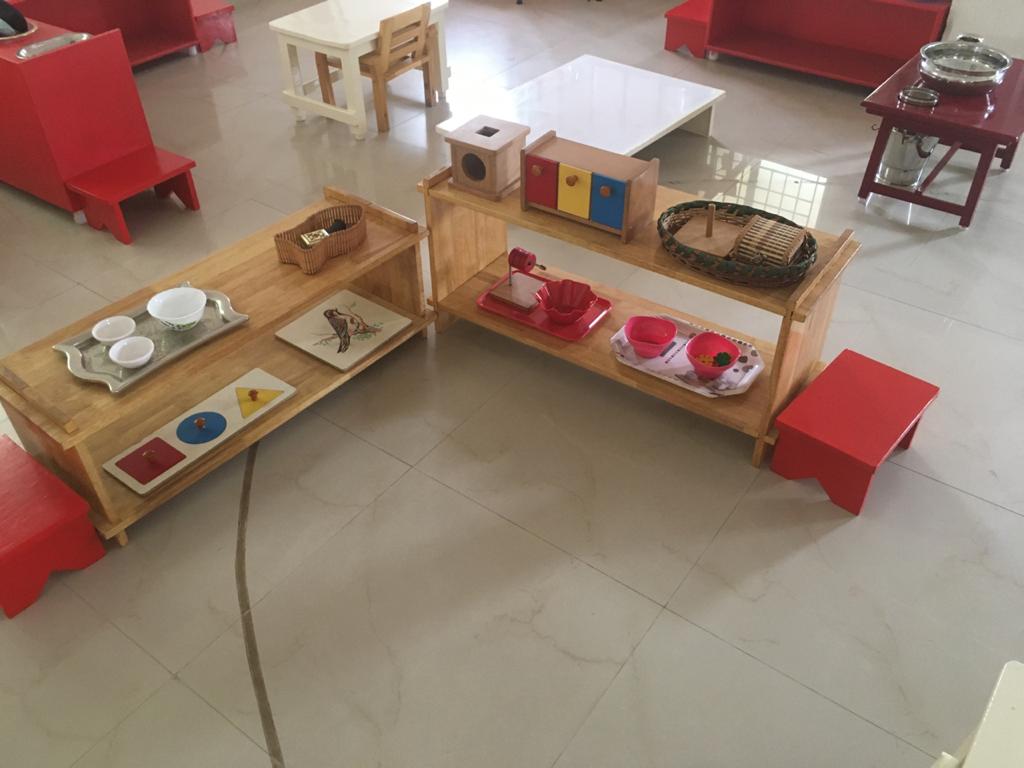INFANT & TODDLER PROGRAM
“Help me to do it by myself.”
During the first 3 years of life, children develop more rapidly than at any other time. During this phase, the child absorbs large amounts of information from the environment through observation and experiences. These are the years that lay the foundation for later learning—and the stronger the foundation, the more they will be able to build upon it.
OUR GOAL OF THE INFANT & TODDLER PROGRAM
“To provide experiences that stimulate the senses, enrich the child’s vocabulary and understanding of spoken language, provide time and space for the child to repeat meaningful activities, show our children how to use tools in their environment such as utensils, brooms, sponges, etc., give children the opportunity to learn, through the experiences, help build a sense of self-esteem, self-worth, and self-confidence.”

The Environment
There are 2 components to the 0-3-year-old age group: a supportive home environment, and a comfortably created toddler community space for the walking children to discover his world by working in it.Understanding and following the needs of the child, and not necessarily those of the adult, the space is created with his success in mind. Furniture is small, very small, to fit the proportions of her body. All of the materials and equipment are life-like, assimilating real objects, but once again, small; designed for use by her tiny hands.
THE SUPPORTIVE HOME ENVIRONMENT
The home environment needs to change dynamically for the infants and the non-walking children to the walking children. 4 distinct areas need to be set up in homes: sleeping, personal care, eating, and living/movement.The area for sleeping needs a cozy, quiet area, with beds on the floor available to the children whenever they need to rest. Personal care and hygiene also has its own space. Bathing, changing, dressing, and everything that leads to developing the awareness and necessity for caring for our own bodies needs to be contained in one area.The eating, or food area, needs a comfortable chair for the adult to feed a baby, to a small sturdy table and chair presenting the child with a different way to eat. Plates, utensils and even drinking cups are all part of the eating area.Every home needs an area where the family gathers. This space needs to provide the child with opportunities to move (and work with hands) at developing the required movement, both gross and fine motor, that he will need to move on to higher learning.
CASCADE works with interested families in setting up the home environment according to the needs of this growing child.
THE TODDLER COMMUNITY (TYPICALLY 14 - 36 MONTHS OF AGE)
This is a community of walking children with two or more adults to facilitate their daily routine. Here too, the room is divided into areas, to help focus the child’s attention on varied interests. The personal care space continues to focus on personal hygiene. We also work on independent dressing and undressing skills, and introduce toileting. The children are also provided opportunities to contribute in maintaining the environment through 'Care of Environment' activities. These include both indoor and outdoor areas. The eating area expands, and now includes a place for the children to help with preparation of the food they will eat. This area is rich in language, sensory input (ah, the smell of ripe bananas, waiting to be cut!) and real experiences, with real tools, for a real purpose.Our “living room” now holds shelves with carefully chosen activities that will match the developmental stages of the child. Shelves are rich with materials to encourage language development, art, music, and manipulative movements. Everything is designed to help the child refine skills that are based on real-life activities. Families enrolling into our Toddler community will be supported to set up the home environment as well.
What do children learn?
The routines of everyday living are the foundation of Montessori Infant & Toddler programs. Activities promote independence, order, coordination, and concentration, as well as support social, emotional, physical, and cognitive development.
Self-care
Washing, dressing, toileting, and eating, according to each child’s individual capacity.
Care of the environment
Cleaning, food preparation and food service; plant care and animal care.
Gross-motor activities
Walking, climbing, running, jumping, balancing, climbing steps, and more...
Fine-motor skills
Reaching, grasping, picking up objects, transferring objects, using tools and utensils, doing art work.
Language
Naming objects, describing actions and intentions, discussing pictures, conversation, music, and singing.
Social skills
Developing manners through interactions with peers, teachers, and adult-led small group games.

